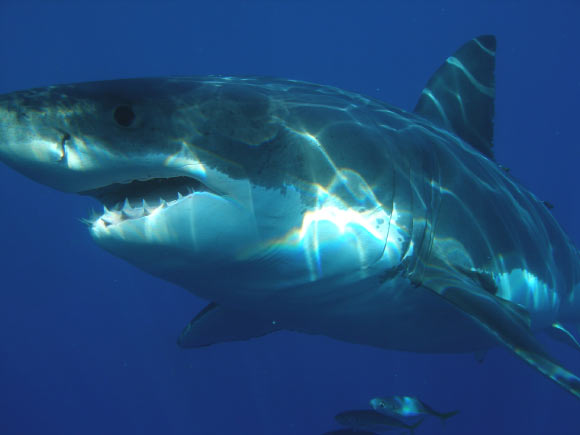The diet of juvenile white sharks (Carcharodon carcharias) is about 32% mid-water fish, 17% bottom-dwelling fish, 5% reef fish, and 15% batoid fish such as stingrays; the remainder is unidentified fish or less abundant prey, according to new research from the University of Sydney and the New South Wales Department of Primary Industries.
University of Sydney PhD candidate Richard Grainger and colleagues examined the stomach contents of 40 juvenile white sharks caught incidentally off New South Wales, Australia.
The researchers compared their data with published data elsewhere in the world, mainly South Africa, to establish a nutritional framework for the species.
They found that based on abundance, the sharks’ diet relied mostly on:
(i) pelagic, or mid-water ocean swimming fish, such as Australian salmon: 32.2%;
(ii) bottom-dwelling fish, such as stargazers, sole or flathead: 17.4%;
(iii) reef fish, such as eastern blue gropers: 5.0%;
(iv) batoid fish, such as stingrays: 14.9%;
(v) the remainder was unidentified fish or less abundant prey; marine mammals, other sharks and cephalopods (squid and cuttlefish) were eaten less frequently.
“Within the sharks’ stomachs we found remains from a variety of fish species that typically live on the seafloor or buried in the sand,” Grainger said.
“This indicates the sharks must spend a good portion of their time foraging just above the seabed.”
“We discovered that although mid-water fish, especially eastern Australian salmon, were the predominant prey for juvenile white sharks in New South Wales, stomach contents highlighted that these sharks also feed at or near the seabed,” said Dr. Vic Peddemors, a researcher in the New South Wales Department of Primary Industries.
“White sharks have a varied diet. As well as east Australian salmon, we found evidence of other bony fish including eels, whiting, mullet and wrasses,” Grainger said.
“We found that rays were also an important dietary component, including small bottom-dwelling stingrays and electric rays.”
“Eagle rays are also hunted, although this can be difficult for the sharks given how fast the rays can swim.”
“The hunting of bigger prey, including other sharks and marine mammals such as dolphin, is not likely to happen until the sharks reach about 2.2 m in length.”
The team also found that larger sharks tended to have a diet that was higher in fat, likely due to their high energy needs for migration.
“This fits with a lot of other research we’ve done showing that wild animals, including predators, select diets precisely balanced to meet their nutrient needs,” said University of Sydney’s Professor David Raubenheimer.
The study was published in the journal Frontiers in Marine Science.
_____
Richard Grainger et al. Diet Composition and Nutritional Niche Breadth Variability in Juvenile White Sharks (Carcharodon carcharias). Front. Mar. Sci, published online June 7, 2020; doi: 10.3389/fmars.2020.00422








